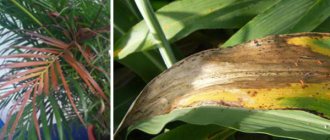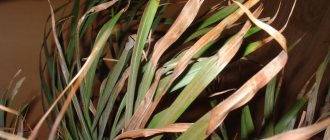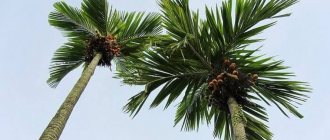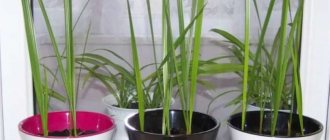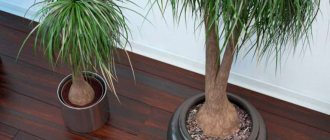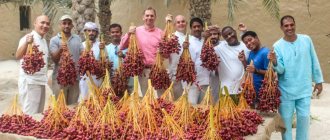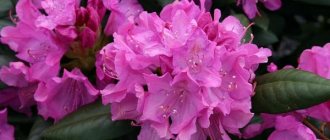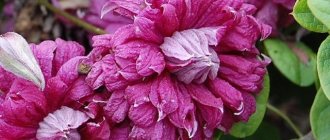Short review
Family: Palms (Arecaceae); Genus: Chamaedorea; Trivial names: mountain palm; Origin: Central America, especially Mexico and Guatemala; Height: usually from 30 cm to 130 cm, rarely up to 200 cm; Dark green feathery leaves; The inflorescence appears between the lower leaf axils after two to three years; Panicles with spherical cream to yellow flowers, similar to acacias; Seeds: small and round, germinate quickly; The plant is heterosexual, requiring two or more plants to produce seeds.
The evergreen mountain palm grows relatively slowly. She is very easy to care for.
Description of the plant
Hamedorea elegans is also known as Hamedorea (neanta, collinia) graceful. Flower growers also call it reed palm, and sometimes bamboo palm. In appearance, the plant resembles bamboo, but it is a palm tree. In its natural environment, it grows in the humid forests of the Mexican tropics.
The graceful collinia is a subshrub with woody stems on which sit long, arched, feathery leaves, colored light green. The height of the flower can reach 150-200 cm.
Hamedorea blooms only at a young age (at 3-4 years), when it reaches a height of 30-40 cm, in the summer. Flowering lasts about 3 months. At the end of spring, a long and strong peduncle is formed, on which small spherical yellow flowers sit. Look at the photo below: they look like mimosa. When the flowers fade, fruits in their place are formed in the form of black berries with a diameter of about 5-6 mm. Only one seed ripens in each berry.
Types and varieties
In addition to the species Hamedorea gracilis, the genus Hamedorea also includes about 100 other species. The mountain palm is the most common indoor plant. Sometimes you can find the more graceful Chamaidores metallika, the long-leaved Chamaedorea graminifolia, as well as the Ernest-August chamaedorea (Chamaedorea ernesti-augustii), the leaves of which look like a fish tail. There are also hybrids, such as Chamaedorea elegans Bella.
Flower diseases
The palm tree seems to be unpretentious, but it is necessary to provide it with additional care, otherwise it may get sick. If there is excess moisture in the pot, the soil has a bad smell, and traces of mold are visible on the surface - all this is a sign of rot. Sometimes the result of improper care is chlorosis, the leaves acquire a yellowish tint. Soil with too much calcium will turn leaves from green to yellow. In a cold room, due to temperature changes, it may even lose its leaves.
It is useful to keep chamedorea in the house, and not only because of its decorative appearance. It is a plant that purifies the air well and is non-toxic and non-poisonous.
Care
Caring for Hamedorea elegans is quite simple. Location, planting substrate and watering are critical. The palm tree needs a lot of water during the growth phase, but the soil should not be constantly wet. Severe drought harms the plant. In summer, the palm tree can be moved outside to a shady place. This is due to the fact that in its homeland the mountain palm is a shady plant that grows under large vegetation and hardly sees the sun. Hamedorea graceful forgives minor mistakes in care, so even beginners can grow it.
Hamedorea gracilis
Location
A bright or partially shaded location is ideal for the mountain palm.
- The plant does not tolerate too much direct sunlight. The leaves of chamedorea turn pale and yellow or brown spots appear on them.
- If Hamedorea dainty is on a windowsill, a location on an east or west window with morning and evening sun is best.
- Most mountain palms also thrive in north-facing windows.
- Please note that the plant grows much slower in a shady location.
- If the chamedorea produces very long stems with particularly small leaves, this is a clear sign that the location is too dark.
- The pot should be installed at a distance of at least 1.5 meters from southern windows with midday sun.
- Blinds or curtains should protect the plant from the midday sun.
- Mountain palm may be exposed to weaker winter sun throughout the day.
- If the tips of the leaves turn brown, this is a sign of insufficient moisture.
The room should be maintained at a constant, moderate temperature all year round. Temperatures between 18 and 22 °C are ideal. In winter – from 13 to 18 °C. From the end of May, Hamedorea graceful can be placed outside on a balcony or terrace. To do this, choose a shady place. However, the plant can easily be kept indoors all year round.
Substrate
Hamedorea graceata grows best in a well-drained (permeable) substrate with low nutrient content and a slightly alkaline pH. Use palm soil or a mixture of 1/2 compost and 1/2 leaf mulch. Regular soil must be mixed with sand. The pot should have a drain hole to remove excess water.
Transfer
Young chamedoreas need to be replanted almost annually. With a good location and suitable substrate, the mountain palm grows quite quickly. You don't want to use too big a pot from the start. Stick to the rhythm of the landing. Older specimens grow much more slowly. When replanting, care must be taken not to damage the roots, otherwise the growth of the plant will slow down. It is best to replant Hamedorea graceful in the spring.
- It is necessary to replant chamedorea only when the roots of the plant are visible from the bottom or top of the pot.
- The best time to transplant is early spring.
- Use a slightly larger pot than the previous one.
- Be careful, the roots are very brittle!
- Drainage at the base of the pot ensures that excess water can drain away well.
Watering
The mountain palm has a high water requirement. At home, its roots grow to groundwater. Without this, palm trees will not thrive. Hamedorea graceful is undemanding and can be watered even with hard tap water.
When watering, pay attention to the following:
- The earth ball should never dry out.
- Watering should be done immediately after the soil surface dries.
- In summer, Chamedorea elegans needs to be watered every two days.
- You can also spray the leaves with water during warmer months.
- In winter, mountain palm requires less liquid. It is enough if you keep the substrate slightly moist.
- Avoid excessive waterlogging.
Fertilizer
During the period from March to September, every two to three weeks it is necessary to supply Hamedorea graceful with liquid fertilizer. To do this, it is enough to apply half the recommended dose. It is best to add fertilizer to irrigation water. Alternatively, you can use fertilizer sticks.
In the first year of the plant’s life and in the first year after transplantation, there is no need to apply fertilizer, since the fresh substrate already contains a sufficient amount of nutrients. It also stimulates root growth in young plants.
Wintering
Chamedorea gracefula is not a winter-hardy plant and should be overwintered indoors. At this time, she prefers a bright and cool place. Temperatures between 13 and 18 °C are optimal. During this time, you should not fertilize the plant. Watering is moderate.
- Rest phase: from October to February.
- In winter, the preferred room temperature should be between 13 and 18 °C. Watering is reduced.
- High air humidity is important. Therefore, it is advisable to regularly spray the palm tree with a small amount of water.
- Don't forget to regularly ventilate the room.
Trimming
Completely wilted leaves are pruned at a distance of about one centimeter from the trunk. To speed up the growth of a palm tree, cut off the rather inconspicuous inflorescences that the plant develops from the second or third year of life as close to the roots as possible. Either way, the bloom is fairly subtle and doesn't offer much visual benefit. This also helps avoid making a mess around the palm when the dried flowers fall off.
Hamedorea gracilis
Possible problems in cultivation and diseases
In most cases, plant death occurs due to improper care.
- Drops buds and leaves
The reason may lie in insufficient watering or, on the contrary, excessive application of water and rotting of the root system. This happens somewhat less frequently due to a lack of micro and macroelements in the soil.
- The leaves are turning pale
Slower growth and pallor of the green mass may occur due to a lack of nutrients, or the temperature in the room itself is below normal.
- The tips of the leaves are drying out
The tips of the leaves can dry out due to non-compliance with the humidity regime in the holding room - it is enough to regularly spray the palm tree and after a few weeks the foliage will recover.
- The lower leaves fall off
Falling of the lower leaves can occur due not only to excessive watering and spraying of the plant, which needs to be reduced, but also to a lack of macro- and microelements. Therefore, in the first case, watering and spraying are reduced, in the second, fertilizing is applied.
Pests
For the most part, Chamedorea elegans suffers from spider mites - this is manifested by the appearance of cobwebs on the leaves, black or red dots. Therefore, it is necessary to regularly spray the plant and wash it in the shower with soap more often.
Palm trees are less commonly affected by insects such as aphids and scale insects, thrips and whiteflies. In this case, the palm tree is sprayed with fungicides.
Other problems
- Young leaves dry out and roots rot. Therefore, it is important to water less often and spray more.
- Brown spots appear on the foliage - this is a consequence of a sharp change in temperature in the room.
- Withering, and then curling of the leaf plate - high ambient temperature. The palm tree is too hot - place it in a cooler room.
proper content is the key to a beautiful look
Everything is quite simple - by observing the conditions of maintenance, the owner receives a luxurious decoration for his home.
Reproduction
Hamedorea graceful can be propagated using seeds or seedlings.
Seeds
If you want to grow slow-growing mountain palms from seed, you will need a lot of patience.
Since the seeds quickly lose their viability, they need to be sown as soon as possible:
- To do this, first place the hard-shelled seeds in a container of warm water and leave them to soak for two days.
- Then fill the pot with loose substrate.
- Apply seeds to the soil and cover them with a thin layer of substrate.
- Place the pot in a warm place with room temperature between 25 and 30°C, always keeping the soil slightly moist.
- Avoid direct exposure to midday sun.
- To create a warm, humid climate while preventing insects from laying eggs, the pot can be covered with clear plastic wrap or wrapped in a clear plastic bag.
- Once the shoots are a few centimeters high, the young plant can be moved to a cooler location. The film must be removed.
Seeds are available in specialty stores.
Hamedorea graceful produces flowers of different sexes in a pot, so female and male plants are needed to form seeds. Since they are visually indistinguishable from each other, you need at least two plants.
If you're lucky, you can pollinate them artificially:
- To do this, brush a thin brush over all colors several times a day.
- If successful, green fruits are formed after flowering.
- When the fruits ripen, they turn black. When the first fruits fall, you can collect them all and use them for planting.
By shoots
Seedlings regularly form at the base of Hamedorea gracilis. They can be separated and used to propagate the plant. Fill the pot with soil and plant the shoot in it.
Place a clear plastic bag over the pot to create a warm, humid climate. This stimulates the growth of the young plant. If the seedling begins to grow, you can remove the bag. Now the young mountain palm needs to be watered regularly.
Reproduction of Hamedorea elegans
Hamedorea elegans is propagated in two ways: by seeds and root layering. The seeds are soaked for 5 days, then the hard outer shell is carefully cut, placed, without covering with soil, in soil consisting of peat and sand (3:1) or in peat tablets and placed in a warm (not lower than +25°) and moderately moist place. place. The germination period of seeds is six months. Root shoots are carefully separated from the mother plant and planted in small pots.
Diseases and pests
In unfavorable conditions, the plant becomes weakened and attracts spider mites or scale insects. Especially in winter, Chamedorea graceful is susceptible to pests in rooms where it is too warm and low humidity. Affected plants must be immediately isolated and treated.
Spider mites
When attacked by spider mites, the leaves become yellowish and thin webs can be seen on the stems and undersides of the leaves. Since pests cannot tolerate high air humidity, the plant should be generously watered and sprayed with water. Then you need to drape a clear plastic bag over the entire plant and secure it to the pot.
This creates a humid and warm climate in which spider mites die within a short time. In addition, you can apply special anti-spider mite products to the plants or spray the spider mites with an acaricide.
Shields
These insects are very difficult to detect and even more difficult to control. Scale insects suck out plant sap, which gradually turns the leaves brown. The well-camouflaged scale insects settle along the leaf veins, but secrete honeydew and can be recognized as small bumps upon closer inspection.
In case of mild infection, the leaves of the plant can be wiped with oil or treated with a soapy alcohol solution. Since the pests are so well protected by their shield-like body, a special plant protection product against scale insects is the fastest way to combat a severe infestation.
The benefits and harms of palm trees
This palm tree not only decorates the room with its luscious appearance, but also has a beneficial effect. The most important thing is that the plant is able to purify the air from pollution and harmful microorganisms and impurities (especially benzene, ammonia and formaldehyde). Chamedorea also increases air humidity.
The culture is completely safe and does not contain toxic substances. The palm tree does not harm either people or animals. In addition, astrologers claim that chamedorea can improve mood and fight depression. The best place to place it is in the living room or dining room.
It is better not to stir the flower in the bedroom. This is explained by the fact that chamedorea is considered a plant of activity and endeavor, and in the bedroom a person should tune in to complete rest and relaxation.
But egoists should not be given such a flower. Signs say that such people, with the appearance of a palm tree in the room, completely cease to be interested in other people’s experiences and problems.
Features of care after purchase
The purchased plant was grown in special industrial conditions, very different from those in which Hamedorea will grow.
Specialists are responsible for the appearance and care, so the plants in stores are always in excellent healthy shape.
Afterwards, the palm tree undergoes transportation and adaptation to other conditions . It is important to make this stage as comfortable as possible.
- The first thing to do is to inspect the plant for diseases and pests. It is unlikely that store-bought Hamedorea will be infected or diseased, but it still doesn’t hurt to be on the safe side.
- Under no circumstances should you replant the palm tree during the first month. This will be additional stress for the plant, and it may become seriously ill. An exception can only be if the delivered soil has traces of mold.
- The palm tree should be provided with optimal lighting, air humidity and a comfortable temperature from the very first days.
- Also, the plant does not need feeding for the first month after purchase.
Selection of location and conditions of detention
Let's find out what conditions need to be provided to the reed palm in order for it to maintain its elegance and remain healthy.
Lighting and location
Hamedorea requires moderate diffuse lighting. It does not need direct rays of the sun, so it cannot be placed on a south window or balcony: the leaves will burn. It is best to place the pot on or near the eastern windowsill. With good artificial lighting, the plant can be placed at the back of the room.
And when using special phytolamps, a palm tree can grow in rooms that do not have access to sunlight at all. It is only important that the duration of daylight hours is not shorter than 10-12 hours during the period of active growth. It is better not to place a flower on an open balcony: a draft can have a bad effect on its development.
Temperature
The optimal temperature for Hamedorea graceful is +20…+27 °C in summer and +12…+16 °C in winter. It is important that the temperature differs slightly during the day and at night (at least by 5-6 °C).
Air and humidity
Reed palm requires high air humidity (70-90%). You can maintain this level if you regularly spray the leaves with lukewarm water. In summer, the frequency of spraying can reach 2 times a day (morning and evening). You can humidify the air around the chamedorea by placing the pot on a tray with wet stones (brick, expanded clay) at the bottom.
Soil and pot
At home, it is better to keep chamedorea in wide and not very deep pots made of plastic or ceramics. There must be drainage holes at the bottom. To ensure good water flow, drainage must also be provided. To do this, you can use torn foam, which is brick, expanded clay or perlite.
A mixture of:
- 1 part washed sand;
- 1 part high peat;
- 2 parts of turf land;
- 2 parts humus.
To plant chamedorea, you can also purchase ready-made flower soil specifically for palm trees.
